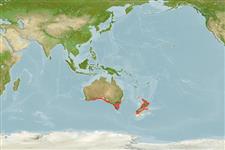Environment: milieu / climate zone / depth range / distribution range
Écologie
marin; saumâtre benthopélagique; profondeur 22 - 400 m (Ref. 58489). Temperate; 32°S - 51°S, 115°E - 179°E
Southwest Pacific: confined to Australian and New Zealand seas.
Length at first maturity / Taille / Poids / Âge
Maturity: Lm 37.5, range 30 - 40 cm
Max length : 76.0 cm TL mâle / non sexé; (Ref. 9002); common length : 50.0 cm TL mâle / non sexé; (Ref. 9258); poids max. publié: 4.0 kg (Ref. 9988); âge max. reporté: 15 années (Ref. 9072)
Adults inhabit continental shelf and slope waters (Ref. 6390). Reported from depths between 22 m (Ref. 58489) and 400m (Ref. 30458). They are schooling species, usually aggregating close to the sea bed (Ref. 26498) although there is some evidence that they move into the middle water column at night (Ref. 30459). Juveniles recorded offshore to a depth of 100 m and sometimes entering estuaries, often in association with jellyfish (Ref. 9563) and schooling close to the surface. Feed mainly on salps but also takes euphausiids, krill, crabs and small squid (Ref. 9072). Marketed fresh and frozen; eaten steamed, fried, broiled, boiled, microwaved and baked (Ref. 9988).
Determinate annual fecundity. Females spawn three batches of eggs in a season (Ref. 86821).
Kuiter, R.H., 1993. Coastal fishes of south-eastern Australia. University of Hawaii Press. Honolulu, Hawaii. 437 p. (Ref. 9002)
Statut dans la liste rouge de l'IUCN (Ref. 130435: Version 2024-2)
Menace pour l'homme
Harmless
Utilisations par l'homme
Pêcheries: commercial; pêche sportive: oui
Outils
Articles particuliers
Télécharger en XML
Sources Internet
Estimates based on models
Preferred temperature (Ref.
123201): 11.8 - 16.6, mean 14.4 °C (based on 98 cells).
Phylogenetic diversity index (Ref.
82804): PD
50 = 0.5156 [Uniqueness, from 0.5 = low to 2.0 = high].
Bayesian length-weight: a=0.01122 (0.00514 - 0.02450), b=3.04 (2.87 - 3.21), in cm total length, based on all LWR estimates for this body shape (Ref.
93245).
Niveau trophique (Ref.
69278): 3.7 ±0.43 se; based on food items.
Résilience (Ref.
120179): Milieu, temps minimum de doublement de population : 1,4 à 4,4 années (K=0.19; tm=3-4; tmax=15).
Prior r = 0.65, 95% CL = 0.43 - 0.97, Based on 2 data-limited stock assessments.
Fishing Vulnerability (Ref.
59153): Moderate to high vulnerability (50 of 100).
Climate Vulnerability (Ref.
125649): Very high vulnerability (77 of 100).
Nutrients (Ref.
124155): Calcium = 17.4 [12.1, 31.0] mg/100g; Iron = 0.272 [0.175, 0.434] mg/100g; Protein = 17.5 [15.7, 19.4] %; Omega3 = 0.669 [0.393, 1.167] g/100g; Selenium = 19.4 [9.7, 34.5] μg/100g; VitaminA = 22.4 [9.6, 57.7] μg/100g; Zinc = 0.533 [0.408, 0.702] mg/100g (wet weight);
